Grumman Ag Cat
The Grumman G-164 Ag Cat is a single-engine biplane agricultural aircraft, developed by Grumman in the 1950s.
| Ag Cat | |
|---|---|
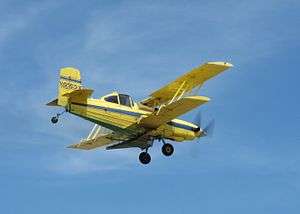 | |
| Ag Cat G-164B | |
| Role | Agricultural aircraft |
| Manufacturer | Grumman |
| First flight | 1957[1] |
| Introduction | 1957[1] |

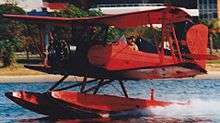
Development
The Ag Cat was the first aircraft specifically designed by a major aircraft company for agricultural aviation,[2] and the first aircraft designed according to the regulations of Civil Aeronautics Manual Part 8, which had been written especially for agricultural aircraft.
In 1955, Grumman preliminary design engineers Joe Lippert and Arthur Koch proposed the design for a "purpose built" crop dusting airplane as a means of fulfilling a pressing need in the agricultural community as well as the perceived need for Grumman to diversify its product lines. The initial market survey indicated that 100 - 200 of this type could be sold each year. Lippert's initial proposal was made under the project name "Farmair 1000."
The first G-164, which was built by Grumman (N74054), was equipped with a Continental W670 Series 6A-16 powerplant. This ship accomplished its maiden flight on May 27, 1957 with Grumman test pilot Hank Kurt at the controls.[2][3] This initial flight test consisted of three short familiarization hops with the take-off weight set at 3122 lbs, and the centre of gravity at 31.2%. Flight tests 2 & 3, with test pilot Victor Eble, were accomplished on May 28, 1958 to evaluate the general flight characteristics. A total of 46 test flights were completed by the end of August 1958 with a general finding that this was a well-behaved aircraft with only minor refinements needed before production.
When the decision was made to authorize production, Leroy Grumman suggested marketing the aircraft under the name "The Grasshopper." However, Dick Reade suggested "Ag-Cat," following Grumman's naming tradition using the suffix "-Cat" in aircraft names (e.g., F4F Wildcat and F6F Hellcat). Mr. Grumman agreed and the Grumman G-164 became the "Ag-Cat." [3]
Large military orders prevented the production of the Ag-Cat at Grumman's Bethpage facility. Grumman's Board of Directors chose to subcontract the entire program to the Schweizer Aircraft Company of Elmira, New York. Initial production was through a contract between Schweizer Aircraft Corporation,[4] and Grumman. The first Schweizer-built Ag-Cat, bearing registration number N10200 flew on October 17, 1958 under the control of Schweizer test pilot Clyde Cook.[3] Full production began in January 1959 with Schweizer delivering 12 FAA certified airplanes to Grumman by March 1959. The FAA granted type certification on January 20, 1959.[5]
The ownership of the Ag-Cat design has changed hands several times. Grumman transferred ownership to its commercial aircraft subsidiary, Grumman American, in 1973. A market feasibility study for a new agricultural aircraft (AgCat X) was completed by Grumman American in 1976. This study indicated that there was a potential market demand for more than 100 aircraft each year. The study also showed that most of the concerns expressed by agricultural aircraft operators were addressed by the AgCat C model. The Grumman American subsidiary, which also owned the Grumman Gulfstream design series, was sold to American Jet Industries in 1978.
From initial production through 1981, Schweizer built 2,455 aircraft under contract.[6] In 1981 Schweizer bought the rights to the design and continued production under the name Schweizer Ag-Cat.[4]Schweizer sold the design to Ag-Cat Corp. of Malden, Missouri in 1995.
Five model G-164B aircraft were produced, and registered, before Ag-Cat Corp. entered bankruptcy. One additional aircraft, a G-164BT500, is listed in the FAA registry as having been produced by Ag-Cat Corp., however no tail number was issued.[7] This may have been an upgrade to an existing airframe.
In February 2001 the design was sold to Allied Ag-Cat Productions Inc. of Walnut Ridge, Arkansas.[5] Allied Ag-Cat are not producing new aircraft although a related company operates a large fleet of Ag-Cats.
The basic airframe incorporates many safety innovations, including a pressurized cockpit to keep pesticides out, air conditioning and a fuselage structure that is designed to progressively collapse in the event of a collision.[4] Lippert and Koch were recognized for their innovation in agricultural aircraft, being awarded the Puffer Award by Delta Air Lines in 1974.[8]
Floats were approved for the aircraft in the early 1990s in Australia.
Variants
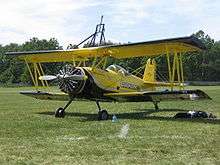
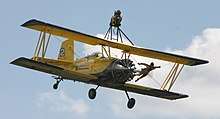
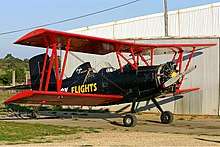
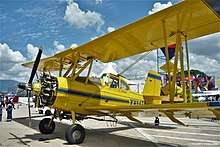
- Ag Cat
- The basic model Ag Cat was certified with four different engines: the 220-225 hp (164-168 kW) Continental Motors radial engine, the 240 hp (179 kW) Gulf Coast W-670-240 radial engine, the 245 hp (183 kW) Jacobs L-4M or L-4MB radial engine and the 275-300 hp (205-224 kW) Jacobs R-755 radial engine. A total of 400 of this model were produced.[6]
- Super Ag Cat A/450
- The G-164A became the main model starting with serial number 401. This model featured a 450 hp (335 kW) Pratt & Whitney R-985 radial engine along with a higher gross weight, increased fuel capacity, larger diameter wheels and improved brakes.[6]
- Super Ag Cat A/600
- The A/600 incorporated the same improvements embodied in the A/400, but was powered by a Pratt & Whitney R-1340 radial engine of 600 hp (450 kW).[6]
- Super Ag Cat B/450
- The B/450 improved on the "A" model by increasing the wingspan from 35 ft 11 in (10.95 m) to 42 ft 3 in (12.88 m). The fin and rudder were enlarged and the fuselage was also lengthened.[6] The upper wing was raised on the "B" model by 8 in (20 cm) to reduce aerodynamic interference between the wings and improve cockpit visibility.[4]
- Super Ag Cat B/525
- The B/525 incorporated the design improvements of the B/450, but was powered by a Continental /Page R-975 engine.[6]
- Super Ag Cat C/600
- The C/600 first flew in 1976. It is similar to the model B/450 but has its fuselage further stretched to incorporate a 500 US gal (1,892 l) agricultural hopper. The model is powered by a 600 hp (450 kW) Pratt & Whitney R-1340 radial engine.[6]
- Turbo Ag Cat D/T
- The "D" model is similar to the C/600 but replaced the radial piston engine with a Pratt & Whitney PT6A turboprop powerplant of 680 shp (507 kW).[6]
- Turbo Ag Cat D/ST
- The D/ST model is identical to the Turbo Ag Cat D/T, but the engine was a Pratt & Whitney PT6A turboprop powerplant of 750 shp (559 kW).[6]
- Turbo Ag Cat D/SST
- The D/SST model is identical to the Turbo Ag Cat D/T, but is powered by a Pratt & Whitney PT6A turboprop powerplant of 850 shp (634 kW).[6]
- Ag Cat B-Plus/600
- Introduced in 1982 the B-Plus/600 is powered by a Pratt & Whitney R-1340 of 600 hp (450 kW). It has the larger hopper of the "C" model.[6]
- Ag Cat B-Plus/450
- Also made available for the first time in 1982 the lowered powered B-Plus/450 is powered by a Pratt & Whitney R-985 of 450 hp (335 kW). This model was available only as a custom order.[6]
- Marsh G-164 C-T Turbo Cat
- This aftermarket conversion was created by re-engining the Super Ag Cat C/600 with a Garrett TPE331-1-101 turboprop, de-rated to 600 hp (450 kW).[6]
- Mid-Continent King Cat
- This aftermarket conversion of the Super Ag Cat C/600 replaced the 600 hp (450 kW) Pratt & Whitney R-1340 engine with a Wright R-1820-202A radial engine that produces 1,200 hp (895 kW).[6]
- Twin Cat
- Aftermarket conversion by Twin Cat Corporation, replacing the R-1340 by two 360 hp (270 kW) Avco Lycoming TIO-540-J flat-six engines, close mounted to the sides of the forward fuselage. Prototype conversion flew in 1979, with conversion kits on sale from 1980.[9]
- Ethiopian Airlines Eshet
- License-built Ag-Cat Super B Turbine with local content from 1986.[10]
Aircraft on display
- National Air and Space Museum, Steven F. Udvar-Hazy Center - G-164A Super Ag-Cat A/600[2]
Specifications (G-164B Super B Turbine)
Data from Jane's Civil and Military Aircraft Upgrades 1994–95[11]
General characteristics
- Crew: 1
- Capacity: 400 US gal (333 imp gal; 1,514 l) in forward hopper
- Length: 27 ft 7.25 in (8.4138 m)
- Wingspan: 42 ft 4.5 in (12.916 m)
- Height: 12 ft 1 in (3.68 m)
- Wing area: 392.7 sq ft (36.48 m2)
- Empty weight: 3,150 lb (1,429 kg)
- Max takeoff weight: 7,020 lb (3,184 kg)
- Powerplant: 1 × Pratt & Whitney Canada PT6A-34AG turboprop, 750 shp (560 kW)
- Propellers: 3-bladed constant-speed propeller
Performance
- Maximum speed: 113 kn (130 mph, 209 km/h)
- Stall speed: 56 kn (64 mph, 104 km/h)
- Never exceed speed: 136 kn (157 mph, 252 km/h)
- Range: 172 nmi (198 mi, 319 km)
See also
Aircraft of comparable role, configuration and era
- Aero Boero 260AG
- Air Tractor AT-802
- Auster Agricola
- Ayres Thrush
- Cessna 188
- Embraer EMB 202 Ipanema
- PAC Cresco
- PAC Fletcher
- Piper PA-25 Pawnee
- PZL-106 Kruk
- Zlin Z-37 Cmelak
Related lists
References
- Notes
- Wood, Derek: Jane's World Aircraft recognition Handbook, page 460. Jane's Publishing, 1983. ISBN 0-7106-0202-2
- Smithsonian National Air and Space Museum (n.d.). "Grumman C-164 Ag-Cat". Retrieved 12 May 2010.
- Schweizer, William: The Ageless Ag-Cat: The Forty-year History of the Ag-Cat Agricultural Airplane, Rivilo Books, 1995 ISBN 0-9630731-1-7
- Montgomery, MR & Gerald Foster: A Field Guide to Airplanes - Second Edition, page 14. Houghton Mifflin Publishing, 1992. ISBN 0-7232-3697-6
- Federal Aviation Administration (February 2001). "Type Certificate Data Sheet No. 1A16" (PDF). Retrieved 1 January 2011.
- Taylor John WR: Jane's Pocket Book Light Aircraft - Second Edition, page 215. Jane's Publishing Company, 1982. ISBN 0-7106-0195-6
- "FAA Registry - Aircraft - Make / Model Inquiry". faa.gov. Retrieved 10 August 2015.
- "National Agricultural Aviation Association". agaviation.org. Retrieved 10 August 2015.
- Taylor 1980, p. 447.
- Lambert 1994, p. 70
- Michell 1994, pp. 398–399.
- Bibliography
- Lambert, Mark, ed. (1994). Jane's All the World's Aircraft 1994-95. Coulsdon, Surrey, United Kingdom: Jane's Information Group. ISBN 0-7106-1160-9.
- Michell, Simon. Jane's Civil and Military Aircraft Upgrades 1994-95. Coulsdon, UK:Jane's Information Group, 1994. ISBN 0-7106-1208-7.
- Taylor, John W. R., ed. (1980). Jane's All The World's Aircraft 1980-81. London: Jane's Publishing. ISBN 0-7106-7105-9.CS1 maint: ref=harv (link)
External links
| Wikimedia Commons has media related to Grumman G-164 Ag-Cat. |